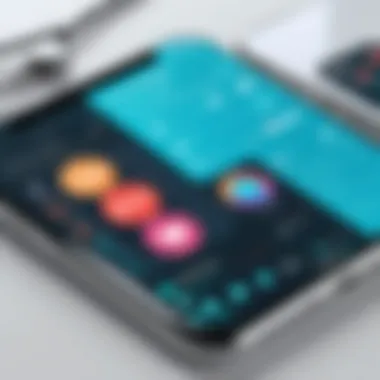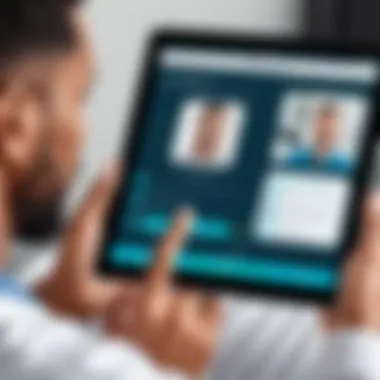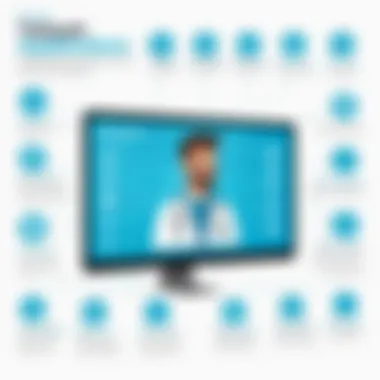Explore Top Free Telehealth Apps for Better Care


Intro
The evolution of telehealth has significantly reshaped healthcare services in recent years. With the rise of technology, patients now engage with healthcare providers remotely, resulting in more accessible medical advice. Free telehealth apps emerge as convenient platforms to bridge the gap between patients and professionals. This exploration aims to delve into the best free telehealth applications available, evaluating key features that make these platforms effective.
Key Software Features
Understanding the essential functionalities of telehealth apps is crucial for both patients and healthcare providers. Key features often include:
- User-Friendly Interface: A simple and intuitive layout ensures effective navigation, reducing the learning curve for users.
- Video Conferencing: This feature allows real-time consultations, which can be vital for accurate diagnosis and treatment.
- Appointment Scheduling: Apps that offer integrated calendars help users manage their visits without manual planning.
- Prescription Management: Some platforms provide electronic prescriptions, simplifying access to medications.
Essential functionalities
Many free telehealth apps focus on delivering basic functionalities. For patients who need immediate support, these applications often feature chat-based consultations. Users can ask questions without needing a video call. This versatility caters to a variety of user preferences.
Advanced capabilities
Beyond basic features, certain applications are pushing boundaries by integrating advanced capabilities. These include personalized health assessments and the use of AI for symptom checking. These technologies enhance the user experience, helping to streamline care delivery and make informed decisions.
Comparison Metrics
Evaluating telehealth applications requires a systematic approach. Comparing various metrics can help identify the best option for individual needs.
Cost analysis
As the focus is on free apps, understanding their limitations is essential. Often, these applications monetize through advertisements or offer premium features. It is important for users to choose an app that maintains quality even in its free offering, minimizing trade-offs when possible.
Performance benchmarks
Performance metrics such as user satisfaction and reliability are important. Some platforms receive high ratings due to consistent service performance. Others may struggle with connectivity or technical issues. Checking user reviews and application ratings can provide insights into their effectiveness.
"An informed choice in telehealth applications can significantly improve healthcare accessibility and quality of care."
Prelude to Telehealth
The rapid growth of telehealth is reshaping how healthcare services are delivered across the globe. As our world becomes increasingly digitized, telehealth plays a crucial role in enhancing patient access to medical care. It is particularly relevant during times of crisis, as we have seen during the COVID-19 pandemic. Yet, it is not just a temporary solution; telehealth represents a fundamental shift in patient-provider interaction.
Definition and Evolution of Telehealth
Telehealth refers to the use of technology to deliver health care services remotely. This concept includes a variety of practices such as video consultations, remote monitoring, and mobile health applications. Telehealth has its roots in the early 1960s when physicians began using telephone and radio technology to consult with patients in remote locations. Over the decades, advancements in the internet, smartphones, and cloud computing have transformed telehealth into a comprehensive ecosystem offering wide-ranging services.
Today, telehealth apps enable patients to connect with healthcare providers without the need for face-to-face meetings. This change not only reduces physical barriers but also increases the efficiency of healthcare delivery. Furthermore, telehealth can significantly streamline processes, minimize wait times, and optimize the use of medical resources.
Importance of Telehealth in Modern Healthcare
The significance of telehealth in contemporary healthcare cannot be overstated. It provides numerous benefits, particularly in improving access for individuals who may reside in rural areas or who have mobility challenges. By minimizing geographical barriers, telehealth fosters timely medical intervention which can lead to better health outcomes.
Moreover, telehealth can enhance patient engagement. With real-time communication tools, patients often feel more involved in their healthcare journey. It can also offer cost-saving benefits for both patients and providers. This aspect is crucial in a time when healthcare costs continue to rise.
"Telehealth bridges the gaps in healthcare access, creating a more equitable system for delivering care."
Key Features of Telehealth Apps
The demand for telehealth services continues to increase, making the evaluation of telehealth apps increasingly critical. Key features of these applications significantly influence their usability, functionality, and overall quality. A well-designed telehealth app needs to ensure seamless interactions between patients and healthcare providers. This section will delve into the critical features of telehealth apps, providing insights into their importance and the benefits they bring to the user experience.
User Interface and Experience
A clear and intuitive user interface forms the backbone of any telehealth application. Users, especially patients, should find it easy to navigate the app without a steep learning curve. A complex interface can deter individuals from utilizing the service effectively. Key elements of a good user experience include clear layout, easy access to features, and a responsive design suitable for various devices such as smartphones and tablets.
Consideration of diverse user needs is also essential. Many individuals seeking telehealth services may not be tech-savvy. Therefore, the interface should cater to varying skill levels while offering tutorials or guidance within the app. The role of user experience cannot be understated; it leads to higher patient satisfaction and improved engagement.


Appointment Scheduling and Reminders
The efficiency of appointment scheduling can make or break a telehealth application. An effective app should allow patients to easily select, modify, or cancel appointments based on their availability. Moreover, integrated reminder systems enhance adherence to scheduled consultations. Reminders can be through push notifications or emails, ensuring patients do not miss crucial appointments.
An example of this feature's importance is seen in behavioral health apps. Patients may require regular check-ins. In such cases, a robust appointment scheduling system, coupled with effective reminders, reduces no-shows and promotes ongoing communication between patients and providers. This aligns well with the growing trend of chronic disease management, where consistent follow-up is paramount.
Patient and Provider Communication Tools
Effective communication is at the heart of any telehealth service. Good apps must facilitate direct and secure communication between patients and healthcare providers. This encompasses chat features, video calls, and secure messaging.
Security is a critical consideration in communication tools. All exchanges of information should comply with privacy regulations. Patients need to feel confident that their personal health information is protected during discussions about their health, including during video consultations.
In addition, communication tools should support varying levels of interaction. Often, a patient may have straightforward questions that require quick answers. A well-integrated Q&A feature can handle these efficiently. Conversely, complex health discussions should be supported by secure video conferencing capabilities. This dual approach enhances the depth of interaction and fosters strong patient-provider relationships.
"Telehealth apps must prioritize communication as much as clinical care because effective communication ultimately impacts health outcomes."
Criteria for Evaluating Telehealth Apps
Evaluating telehealth apps requires careful consideration of several critical factors. As the adoption of these platforms increases, understanding their capabilities helps users make informed decisions. Security, accessibility, and integration with health records are pivotal in showcasing how effectively these apps can serve different user needs.
Security and Privacy Compliance
The importance of security and privacy cannot be overstated in telehealth. Telehealth applications often handle sensitive personal health information. Therefore, compliance with regulations such as HIPAA in the United States is paramount. Users must ensure that their chosen app has robust encryption methods and data protection measures.
To assess security, users should look for features such as:
- Strong user authentication protocols
- Regular security audits
- Clear privacy policies regarding data sharing and storage
A telehealth app that prioritizes security fosters user trust. If patients feel their information is secure, they are more likely to engage fully with digital healthcare options.
Accessibility for Diverse Users
Accessibility is a fundamental aspect when evaluating telehealth apps. A good app should cater to a wide range of users, including those with disabilities. Features like voice commands, screen readers, and customizable font sizes enhance usability for everyone.
It is also essential for apps to support various languages. This consideration opens up access to non-native speakers and diverse cultural backgrounds. A user-friendly design that ensures easy navigation can make a significant difference in patient engagement.
Integration with Health Records
Seamless integration with existing health records is another critical criterion. Telehealth apps that connect with systems like Epic or Cerner provide users and providers with a more holistic view of patient health. This integration allows for:
- Better management of medications
- Streamlined appointment scheduling
- Access to lab results and historical health data
When evaluating an app, users should inquire whether it supports interoperability with different health record systems. This capability enhances the quality of care and ensures that healthcare providers have the necessary information to make informed decisions.
"The efficiency of healthcare is enormously improved by utilizing telehealth applications that meet these evaluation criteria."
By focusing on these aspects, users can select telehealth apps that not only meet their needs but also contribute positively to their overall healthcare experience.
Overview of the Best Free Telehealth Apps
The importance of reviewing telehealth applications lies in the significant role they play in modern healthcare. With a surge in demand due to the COVID-19 pandemic and changing attitudes toward remote health services, understanding how to navigate the options is essential. Free telehealth apps provide a gateway for individuals to access healthcare services, making healthcare more affordable and accessible. This section highlights some key free applications, emphasizing their features and benefits, which can serve a variety of user needs.
Benefits of Using Free Telehealth Apps
Free telehealth apps can dramatically change how patients interact with healthcare providers. Their key benefits include:
- Cost Savings: Many of these apps charge nothing for a basic service, eliminating financial barriers typically associated with healthcare.
- Accessibility: Users can connect with healthcare professionals from anywhere, which is especially valuable for those in rural or underserved areas.
- Flexibility: Users have the option to consult with providers at any time, reducing the need for travel and waiting rooms.
- Variety of Offerings: Different apps cater to numerous conditions and needs, such as mental health, chronic disease management, and urgent care.
The challenge, however, is choosing the right app. The following subsections will delve into four prominent apps, examining their features and user feedback to assist potential users in making informed decisions.
App One: Features and Benefits
User Reviews and Ratings


User feedback is a vital aspect of evaluating telehealth apps. Reviews from previous users often point to the user-friendliness of the app, quality of medical advice, and overall satisfaction. High ratings usually indicate a strong user base that appreciates the app's effectiveness.
One distinct aspect of user reviews is how they highlight the responsiveness of healthcare professionals. Fast response times are often mentioned as a significant advantage of the app. Poor reviews pointed out issues with connectivity or long wait times, emphasizing the variability in user experiences.
Typical Use Cases
Common scenarios for using this app include routine check-ups, mental health consultations, and other primary care services. Users appreciate the app's efficiency, allowing them to manage minor health concerns without the hassle of in-person visits. The app is particularly popular among busy urban professionals who value the convenience of virtual healthcare.
App Two: Features and Benefits
User Reviews and Ratings
User reviews for this second app reveal its strong emphasis on patient-provider communication. Many reviews cite high satisfaction due to the detailed explanations received during consultations. This level of engagement fosters user trust and loyalty. That said, some users reported difficulties in the initial setup process, which may deter new users.
Typical Use Cases
This app is frequently used for dietary consultations and lifestyle coaching, making it a favorite among users looking to enhance their well-being. The unique aspect of this app is its integration with health monitoring devices, which allows real-time data to inform consultations. However, not all users have compatible devices, which limits its reach.
App Three: Features and Benefits
User Reviews and Ratings
Reviews of the third app highlight its step-by-step guides and educational resources, which contribute positively to user experience. Many users find value in the comprehensive nature of the services provided. Some reviews, however, mention that while the resources are extensive, they can be overwhelming for those seeking quick answers.
Typical Use Cases
The app is suitable for patients managing chronic conditions, such as diabetes and hypertension. Users appreciate the personalized care plans developed based on their health data. The primary downside includes the need for consistent engagement from users to maximize benefits, which some may find challenging.
App Four: Features and Benefits
User Reviews and Ratings
This app has garnered attention for its simple interface and straightforward functionality. User reviews reflect a high level of ease when scheduling appointments and accessing health information. However, limited specialty services have resulted in some customer dissatisfaction, as users desire broader healthcare options through the app.
Typical Use Cases
Most often, users turn to this app for immediate assistance with non-emergency issues, including prescriptions and follow-ups from previous appointments. The app excels in helping patients manage their ongoing healthcare tasks efficiently. That said, it is less effective for complex or urgent health concerns, which require in-person visits.
The evaluations of these applications provide a glimpse into the evolving telehealth landscape. By understanding their diverse features and user feedback, individuals can choose the app that best fits their healthcare needs.
Pros and Cons of Using Telehealth Apps
The utilization of telehealth apps brings forth numerous perspectives, worthy of consideration. As technology integrates deeper into healthcare, recognizing both their strengths and weaknesses is essential for stakeholders. This section explores the advantages and limitations associated with telehealth apps, guiding users in making informed choices regarding their healthcare.
Advantages of Telehealth Apps
Telehealth apps offer a multitude of benefits. First and foremost, they significantly enhance accessibility. Patients can consult with healthcare providers from the comfort of their homes. This is especially beneficial for those living in rural areas or those with mobility challenges.
In addition, they can reduce wait times. Traditional in-person visits often involve lengthy waits, whereas telehealth often allows for quicker access to professionals. Also, these apps usually provide a wide range of services, from general consultations to specialist referrals.
- Cost-effective: Telehealth can often reduce healthcare costs for both patients and providers. No travel expenses or time off work is needed.
- Convenience: Users can schedule appointments at times that suit them, combining consultations with routine activities.
- Comprehensive health monitoring: Some telehealth apps allow integration with wearable devices, enabling continuous monitoring of health metrics.
"Telehealth apps represent a paradigm shift in how healthcare is delivered, breaking down geographical barriers and increasing convenience for patients."
Limitations and Challenges
Despite their many advantages, telehealth apps do have some limitations and challenges. One major concern is the quality of care. In some cases, virtual consultations may not be as thorough as in-person visits. This can be critical when physical examinations are necessary for accurate diagnosis.
Additionally, not all patients may be tech-savvy. This can create barriers for demographics that are less familiar with technology, particularly among older adults. Access to the necessary technology itself can also pose challenges.


- Data security: Privacy concerns are prevalent due to the sensitive nature of health information being shared over online platforms.
- Regulatory complexities: Different jurisdictions have various regulations that can complicate the practice of telehealth.
- Insufficient reimbursement policies: In some cases, insurance may not fully cover telehealth services, leading to unexpected out-of-pocket costs for patients.
Case Studies
Case studies serve as an invaluable resource in understanding the real-world impact of telehealth apps. They provide context and evidence of how these applications have influenced the healthcare landscape in practical situations. By examining specific instances, decision-makers can gauge the effectiveness of telehealth solutions in enhancing patient care, improving accessibility, and streamlining healthcare processes.
These case studies allow stakeholders to recognize best practices, pitfalls, and unexpected outcomes that may not be apparent in theoretical discussions or promotional materials. They highlight the user experience directly, offering insights into patient and provider interactions with telehealth platforms.
Successful Implementation in Healthcare Facilities
Successful implementation of telehealth apps in healthcare facilities demonstrates their potential. Many hospitals and clinics have adopted these technologies, leading to increased efficiency and improved patient outcomes. For example, a regional hospital may integrate a telehealth platform like Doxy.me to facilitate remote consultations, especially in underserved rural areas. This transition not only reduces wait times but also enhances patient satisfaction by providing convenient access to care.
Key considerations when implementing telehealth solutions:
- Staff Training: Ensuring that healthcare providers are comfortable and proficient in using the technology can make a significant difference in adoption and efficacy.
- Technical Support: Offering reliable technical assistance is crucial. Issues may arise during consultations that can disrupt the experience for both clinician and patient.
- Patient Education: Informing patients about how to use telehealth services is vital for engagement. Clear instructions can reduce frustration and lead to better health outcomes.
User Experiences: Personal Accounts
Personal accounts from users provide a rich narrative of telehealth's practical implications. As telehealth becomes more prevalent, shared experiences illuminate both its strengths and weaknesses. These stories often reveal user perceptions and the emotional aspects related to remote consultations.
For instance, one patient may express relief at the simplicity of scheduling a video visit through an app like Zocdoc. Another may share frustration due to connectivity issues during an important mental health appointment via Talkspace.
Common themes in user experiences:
- Convenience: Many users appreciate the ability to consult healthcare providers from the comfort of their homes. This is especially valuable for those with mobility challenges.
- Access to Specialists: Patients often highlight that telehealth apps open doors to specialized care that was previously inaccessible due to geographic constraints.
- Privacy Concerns: Some users voice apprehensions about security, feeling uncertain about data protection in digital consultations.
These accounts serve as a testament to the transformative nature of telehealth apps. They illustrate the diverse scenarios in which these platforms operate, providing critical lessons for future developments and implementations.
Future Trends in Telehealth Apps
Exploring future trends in telehealth apps is critical for understanding the evolving landscape of healthcare. As technology advances, these platforms continue to reshape how healthcare is delivered. Patients increasingly expect efficient and seamless experiences. It is vital to stay informed about these trends to maximize the benefits of telehealth applications.
Emerging Technologies in Telehealth
Emerging technologies play a significant role in enhancing telehealth applications. Some of the technologies to watch include:
- Artificial Intelligence: AI is transforming diagnostics and personalized treatment plans. It can analyze patient data to recommend healthcare options efficiently.
- Wearable Devices: These tools monitor vital signs and health metrics in real time. Integration with telehealth apps provides healthcare providers with continuous data for better decision-making.
- Blockchain: For enhanced security, blockchain technology can help protect patient data against breaches. This supports compliance with regulations and increases patient trust.
The combination of these technologies will lead to more connected and responsive healthcare systems. This connectivity can drastically improve the quality and accessibility of care. Therefore, it is crucial for stakeholders to consider how these emerging technologies can be leveraged effectively.
Regulatory Changes and Impacts
Regulations surrounding telehealth are in constant flux. Monitoring these changes is essential for anyone involved in healthcare technology. Increasingly, agencies are adapting policies to promote telehealth access. For instance, the Centers for Medicare & Medicaid Services has broadened coverage for telehealth services. This expansion can potentially pave the way for more innovative apps.
The impacts of these regulatory changes can be both positive and negative. On one hand, increased coverage enhances patient access to care. On the other hand, compliance with new regulations may pose challenges for app developers. Understanding the compliance landscape can inform better design choices and feature sets.
In summary, keeping track of regulatory changes helps healthcare providers and developers remain ahead. This preparedness ensures that they can adapt their services in a way that aligns with evolving requirements, ultimately benefiting patients.
End
The discussion surrounding the importance of telehealth apps has reached a critical peak. As healthcare continues to evolve, telehealth applications play a significant role in enhancing patient experience and healthcare delivery. Through this article, we have explored various facets of free telehealth apps and their implications on modern healthcare.
Recap of Key Insights
Telehealth applications have transformed the way patients access healthcare. They offer a level of convenience that traditional methods often lack. Key insights from our exploration include:
- Accessibility: Patients from diverse backgrounds can easily reach healthcare services.
- Cost-Effectiveness: Many top-tier telehealth solutions are available for free, reducing the financial barrier for users.
- Communication Tools: An emphasis on patient-provider communication fosters better understanding and improved outcomes.
- User Experience: A well-designed interface contributes significantly to user satisfaction.
These elements highlight not just the advantages but also the necessity of telehealth apps in today's world.
Final Thoughts on Selecting a Telehealth App
When it comes to choosing a telehealth app, several considerations must be taken into account:
- User-Friendly Design: A seamless interface ensures users of all skill levels can navigate easily.
- Feature Set: Look for an app that meets specific healthcare needs, such as appointment scheduling and secure messaging.
- Compliance with Regulations: Ensure that the chosen app adheres to HIPAA or other relevant regulations to protect privacy.
- User Reviews: Pay attention to feedback from existing users to gauge reliability and efficiency.
In summary, selecting the right telehealth app is paramount. With many options available, informed decisions can lead to significant improvements in accessibility and quality of care.



